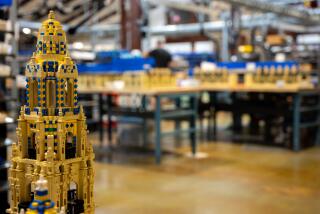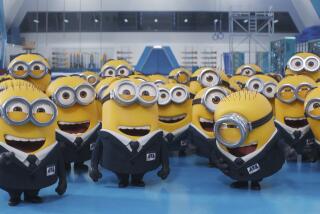A toy story crying out for film
The name Harvey Weinstein conjures images of art films and Oscar contenders. Lego, meanwhile, suggests toys for boys. Not exactly an obvious match.
But the Miramax Pictures co-chairman and the toy company are united in an ambitious product called Bionicle. To anyone without an adolescent boy in the house that may look like a typo. However, anyone who does have contact with preteen males knows that Bionicle is a Lego toy that was at or near the top of many holiday wish lists. It’s also the subject of a recently released direct-to-video computer-generated feature from Miramax (the first animated film it’s made).
If Weinstein and Lego have their way, the success Bionicle is enjoying at toy stores will translate to a successful DVD movie franchise, and maybe even a feature film.
Although “Bionicle: Mask of Light: The Movie” has garnered favorable reviews in online forums, including Amazon.com, a toy-based, direct-to-video feature may seem an odd choice for Miramax. Turns out that just like so many parents before him, Weinstein made a business decision at least partly influenced by his children.
“It’s just the right time in the maturation of the company to get into animation: Harvey Weinstein has three young girls, and getting into family films is a passion of his,” said Jeffrey Tahler, Miramax’s vice president of acquisitions.
“With this film, we had the opportunity to get involved not only with a great toy, but a great story,” Tahler continued. “This toy line was a media property that was missing one thing: the media. We didn’t need to try and force a story onto a hot toy; the story was already there. The characters and the world already existed; we just had to bring it all into a new medium.”
Like many anime series, “Bionicle” entered pop culture under the radar of the mainstream media. In the 1990s, Lego made licensing deals for characters from “Star Wars” and “Harry Potter,” as well as Winnie the Pooh and Mickey Mouse. But they also wanted a property they would own in its entirety and that would incorporate characters and a world of its own.
“A team of people from different backgrounds created a story of seven books and planned to reveal one book each year in the overall story arc. It was the first time where we had a long-term perspective on something from the outset,” explained Conny Kalcher, vice president of global innovation and marketing for Lego, in a telephone interview from Denmark. “They created a concept that was bigger than just a toy and launched it as if it were a movie -- even though we had no movie then.”
Bionicle (a combination of “biological” and “chronicle”) was designed to appeal to kids who might not be interested in standard Lego blocks, Kalcher continued. “The Bionicle boy is not the traditional Lego boy; he’s much more action-oriented, and he likes having the latest and the greatest. He’ll search for details of the story on the Internet and discuss them with his friends. They really love the strange names and codes and heroes. If you met the team who’s been working on this project, you’d see they’re all big Bionicle boys themselves.”
Miramax’s Tahler agrees. “I think Lego has done a masterful job of making Bionicle hip. The Lego toys were always popular, but they were pretty mainstream. They didn’t want kids who played with Bionicle toys to feel they were giving up their hipness. They built a world that’s saturated with mystery and includes all sorts of interesting characters. The actual toys are pretty cool: I take them home and when my friends come over, the first thing they do is ask if there’s anything to put together.”
The Bionicle toys suggest well-designed robots, especially the evil beings called Rahkshi. Although the instructions are unusually clear, it can take as long as 20 minutes to assemble their jointed, girder-like limbs, spiny torsos, reptilian heads and double-bladed pole-axes. Like the Gundam robots, they’re not intended for violent, heavy-duty play. In addition to the models, there are video games, trading cards, T-shirts, backpacks and other products.
The mythological world of “Bionicle” may be new for Lego and Miramax, but it’s not that different from numerous anime properties that are on the air and/or available on video. Anyone familiar with “Dragon Ball Z,” “Vandred,” “Record of Lodoss War: Chronicles of the Heroic Knight,” et al. will recognize the basic pattern.
The tropical island of Mata Nui is protected by the Toa, six legendary warriors whose powers are linked to earth, air, water, fire, stone and ice. But they can no longer resist the sinister Makuta, who has dispatched the Rahkshi to find the Mask of Light that would allow the Seventh Toa to emerge.
Two ordinary Matoran villagers, Takua the Chronicler and his best friend, Jaller, find a mysterious mask. After numerous battles, chases and consultations with wise elders, Takua dons the mask and becomes Takanuva, the Seventh Toa. The film ends with the characters moving to a new island, the setting of the next installment. A second direct-to-video film is already in the works for fall, and preproduction work has begun on a theatrical feature, tentatively scheduled for 2006.
“Mask of Light” was directed by David Molina and Terry Shakespeare, both of whom worked on Disney’s “101 Dalmatians” and various other traditional animated projects.
When the first wave of product-based cartoons appeared in the 1980s, the big and small screens were used to hawk Care Bears, Strawberry Shortcake, My Little Pony, Transformers, and He-Man and the Masters of the Universe. Watchdog groups complained that these “entertainments” were little more than long commercials. Twenty years later, many of the watchdog organizations have disbanded and the protests are muted, as virtually every major film or TV series has become (or tried to become) a franchise. Is “Bionicle: Mask of Light” just the latest toy-based infomercial?
“This is not about doing a commercial: We haven’t taken marketing dollars and moved them to this area,” Kalcher said. “I think people should judge the film by whether the kids have a good experience. Today, properties for kids come from rides, books, TV and everywhere else. It doesn’t really matter where a property comes from if kids like it and are inspired by it. If this project was intended as a commercial, we’d be better off spending the money on commercials and airing them more often.”
More to Read
The biggest entertainment stories
Get our big stories about Hollywood, film, television, music, arts, culture and more right in your inbox as soon as they publish.
You may occasionally receive promotional content from the Los Angeles Times.










